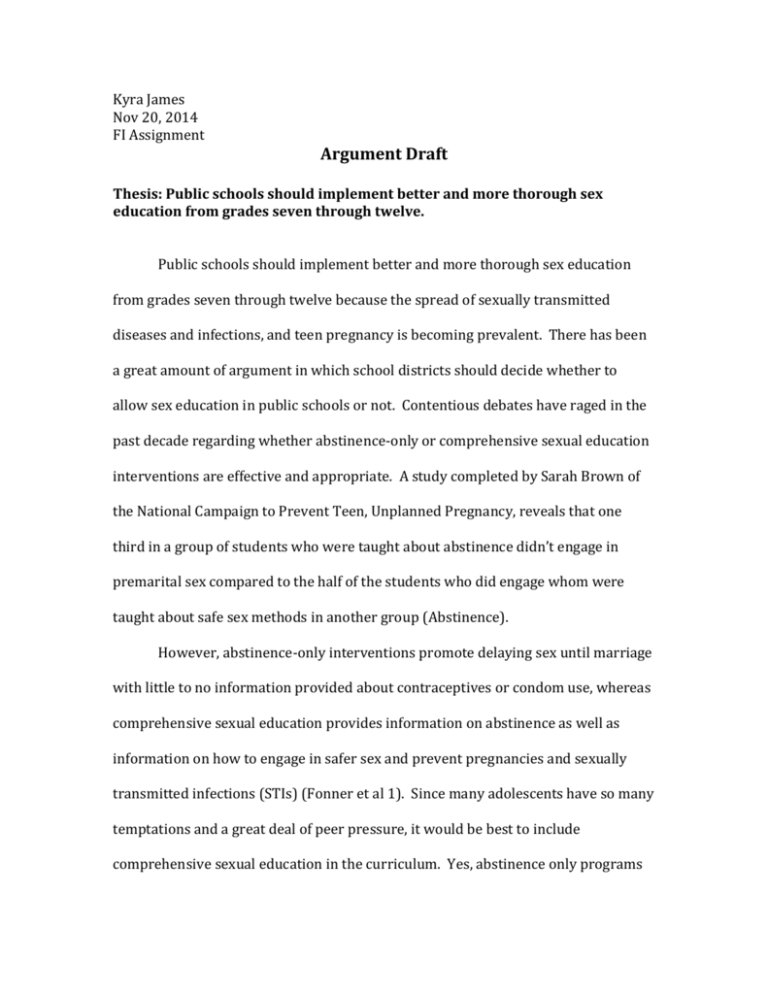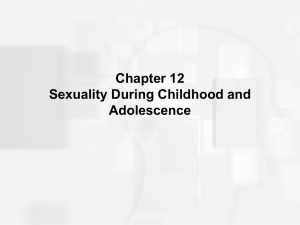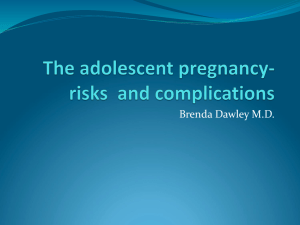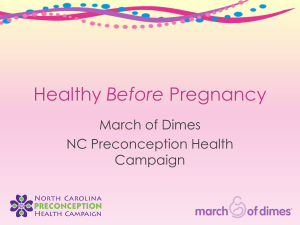
Kyra James
Nov 20, 2014
FI Assignment
Argument Draft
Thesis: Public schools should implement better and more thorough sex
education from grades seven through twelve.
Public schools should implement better and more thorough sex education
from grades seven through twelve because the spread of sexually transmitted
diseases and infections, and teen pregnancy is becoming prevalent. There has been
a great amount of argument in which school districts should decide whether to
allow sex education in public schools or not. Contentious debates have raged in the
past decade regarding whether abstinence-only or comprehensive sexual education
interventions are effective and appropriate. A study completed by Sarah Brown of
the National Campaign to Prevent Teen, Unplanned Pregnancy, reveals that one
third in a group of students who were taught about abstinence didn’t engage in
premarital sex compared to the half of the students who did engage whom were
taught about safe sex methods in another group (Abstinence).
However, abstinence-only interventions promote delaying sex until marriage
with little to no information provided about contraceptives or condom use, whereas
comprehensive sexual education provides information on abstinence as well as
information on how to engage in safer sex and prevent pregnancies and sexually
transmitted infections (STIs) (Fonner et al 1). Since many adolescents have so many
temptations and a great deal of peer pressure, it would be best to include
comprehensive sexual education in the curriculum. Yes, abstinence only programs
do not promote sex and promote that the best way to avoid sexual risks, such as
pregnancy or infections, is to not engage in premarital sex, but what about the
adolescents that do end up engaging in premarital sex? These teens are left
unknowledgeable about precautions and premeasures they should take in order to
avoid such risks.
Since abstinence-only education programs only inform about abstinence,
adolescents would not be informed about the consequences or risks they are taking
when engaging in sexual activities before marriage. They are therefore left clueless
or with misconstrued ideas about certain outcomes regarding relationships,
pregnancy, and sexually transmitted diseases and infections. Previous research has
been conducted on the effectiveness of youth-oriented HIV prevention and sex
education interventions in school settings. A review of 35 school based sex
education programs by Kirby and Coyle found that abstinence based programs had
no significant effect on delaying sexual debut, while some comprehensive programs
were effective in reducing certain sexual risk behaviors (Fonner et al 2). This
research allows the argument that public schools should implement sex education
because it aids in the spread of some infections and diseases. School-based sex
education is an intervention that has been promoted to increase HIV-related
knowledge and shape safer sexual behaviors to help prevent new infections among
this vulnerable group (Fonner et al 1). Sexual education is not a tactic used to scare
adolescents, rather inform them and prepare them for such actions and their
possible outcomes.
Public schools should implement better and more thorough sex education
throughout grades seven through twelve because information about sexual
contraception’s and prevention methods provided by the sexual education
curriculum in public schools is a purposeful way to prevent adolescents from
increasing their risk of either pregnancy or infections and diseases. Numerous
evidence-based sexual health education programs have proven effective in delaying
sexual initiation or increasing contraceptive use (Finley 315). This report suggests
that although nearly all younger female teens received some form of sexual health
education, only six in ten reported that information on both birth control and how to
say no to sex were covered (Finley 315). Of particular concern is that for most
sexually experienced females aged 15-17 years, formal sex education did not
precede their first sexual intercourse (Finley 315). This represents a missed
opportunity to introduce medically accurate information on abstinence and effective
contraceptive use (Finley 315). Due to the lack of misrepresented information,
teens are not suitably ready to engage in such activities. Only 1% of sexually active
females aged 15-17 years were using LARCs [long-acting reversible contraceptives],
which have the lowest failure rate among reversible methods of contraception and
are safe for use for females of all ages, including teens. Long-acting reversible
contraceptives are birth control methods in which the user doesn’t take any
required action to keep it effective. Such contraceptives include injections,
intrauterine devices (IUDs) and subdermal implants. The more a child knows about
the consequences of and risks of underage sex, the more they will take more
preventive and precautionary measures. Although, the school system is a good
place to implement such ideas, the real information should come from the parents of
an adolescent. Parents are a particularly strong influence on the sexual behavior of
teens, however, almost a quarter of females aged 15-17 years have not spoken with
their parents about how to say no to sex or about methods of birth control (Finley
315). In addition to providing information on normal sexual development, health
relationships, abstinence, and prevention of pregnancy and sexually transmitted
diseases, the quality of parent-child relationships and monitoring teen activities and
behaviors are also important in helping a teenager make healthy decisions (Finley
315). If adolescents are not getting this important information from the parents or
other family members, then if sex education was a part of the curriculum, they
would definitely be getting a great deal of information from another authority figure
and source.
Public schools should implement better and more thorough sex education
throughout grades seven through twelve because many countries around the world
are facing the same dilemma about whether to accept sexual education, leaving
adolescents clueless and naïve. Just like the United States, other countries such as
Hong Kong and Northern Ireland are debating the idea of whether sex education is
an appropriate subject to teach the youth in school systems. Hong Kong has three
different views and definitions of what sex education is and should consist of. The
‘traditional emphasis’ is basically an instruction on reproductive biology and
focuses on the anatomy and physiology of the reproductive systems (Che 283). The
‘abstinence-only emphasis’ considers abstinence as the only solution to teenage
pregnancy and sexually transmitted diseases (Che 283). The ‘comprehensive
emphasis’ believes that the best way to educate adolescents about their sexuality is
by preparing them for the healthy expression of their sexuality instead of focusing
only on the prevention of negative consequences (Che 283). In the United States,
the National Guidelines Task Force (1991) has defined sex education as follows:
“Sexuality education is a lifelong process of acquiring information and forming
attitudes, beliefs, and values about identity, relationships, and intimacy. It
encompasses sexual development, reproduction health, interpersonal relationships,
affection, intimacy, body image, and gender roles. Sexuality education addresses the
biological, socio- cultural, psychological, and spiritual dimensions of sexuality ...
including the skills to communicate effectively and make responsible decisions.”
(Che 283) These views lead to uncompromised situations among the officials who
are responsible for such decisions. In Hong Kong, since everybody doesn’t approve
the ‘comprehensive emphasis’, thorough sex education is not implemented. This is
the same situation in Northern Ireland and the United States as well. In Hong Kong,
generally speaking, the young people today have an earlier onset of puberty than
their predecessors (Che 282). However, they are still deficient in sexual knowledge.
Many of them have a sense of inferiority about themselves (Che 282). They are very
susceptible to peer group influence (Che 283). Previous surveys also revealed the
following needs of Hong Kong’s young people in the area of sex education: to have
more information about sex; to have proactive teaching about courtship, marriage
and parenthood; to develop self-esteem, unbiased gender roles and the ability to
play a constructive role in the family; and to clarify values and make responsible
decision on issues relating to sex (Che 283). Northern Ireland youth also claim that
there is valuable information that is missing in their sex education curriculum. The
youth criticize the system in that there are evident flaws, such as, the avoidance of
discussion of emotional aspects of sexuality; the focus within sex education on
reproduction rather than sexuality; the absence of a ‘discourse of desire’, especially
for girls, and a concentration instead on the dangers of desire for women—
pregnancy, abortion, sexually transmitted infections (STIs), etc; a narrow definition
of sexuality simply as sexual intercourse; the frequent avoidance of any proper
discussion of homosexuality; the failure to engage boys, who complain of an
emphasis solely on what happens to girls; and an awkwardness on the part of
teachers with the resultant failure to answer ‘awkward’ questions (Rolston et al
217). This information shows that countries all around the world face the same
issue as the United States in regards to allowing a thorough and informative sex
education class become a part of the curriculum. Incorporating the curriculum
would better suit teenagers and allow them to explore their feelings with the
information to protect them and prevent certain consequences of engaging in sex.
Public schools should implement better and more thorough sex education
throughout grades seven through twelve because the Center for Disease Control and
Prevention states that cases of chlamydia are at its highest and cases of gonorrhea
and syphilis are ever increasing. Public schools should implement this information
because STDs pose a greater threat for women rather than men.
The Center for Disease Control states that in order to help adolescents make
healthy choices, involvement from families, community, and other sectors including
school, are an essential part to the effort. Since there is a lack of thorough sex
education in schools, and even general sex education in schools, statistics of teen
pregnancy and infections are growing. Untreated gonorrhea and chlamydia can
result in pelvic inflammatory disease in women, a condition that can cause infertility
(Center for Disease Control). CDC surveillance also shows much higher rates of
reported STDs among some racial or ethnic minority groups than among whites
(Center for Disease Control). A range of factors contributes to these disparities,
including poverty, lack of access to health care and an already high prevalence of
STDs in communities of color that increases a person’s risk of infection with each
sexual contact (Center for Disease Control). Since people of color are already at a
risk for contracting these diseases, sex education would definitely lower the chances
of a person of color contracting the disease, spreading the disease, and infecting
others. The growing increase in STD infections not only hurts those that have been
infected, but also takes a toll on the United States health care system. In total, the
CDC estimates that there are approximately 19 million new STD infections each
year, which cost the U.S. healthcare system $16.4 billion annually and cost
individuals even more in terms of acute and long-term health consequences (Center
for Disease Control). Accurate and convincing information given to adolescents,
which would be provided by public schools, would give adolescents a better fighting
chance to avoid and prevent contracting these diseases.
Public school systems should implement better and more thorough sex
education from grades seven through twelve because they have an obligation to
inform students about the consequences of sex at a young age and the possibility of
teenage pregnancy and abortion. Public schools must inform students about these
consequences because school is where many children learn many lessons about the
world. If public schools fail to share necessary information, especially concerning
the responsibilities of sex, adolescents are left impressionable and are more
vulnerable to getting themselves into life-changing situations. Schools implement
many other subjects for education that will benefit students’ futures, so why not
implement sex education since it has a big impact on the life and future of children
as well? Many public schools currently do not include sex education in their
curriculum and as a result, the majority of those schools have higher teenage
pregnancy rates. If public schools are not informing children about this important
information, children will be misinformed and make risky and costly mistakes.
Premarital sex could possibly lead to pregnancy. For some teens and their families,
an unwanted pregnancy leads to consideration of abortion (Benson 440). In the
2006–2008 cycle of the National Survey of Family Growth, 49% of all pregnancies
were reported to be unintended (Peipert et al 1291). Of these, 29% were mistimed,
19% were unwanted, and 43% ended in abortion (Peipert et al 1291).
Approximately half of unintended pregnancies result from nonuse of contraception,
and half result from inconsistent or incorrect use and contraceptive failure (Peipert
et al 1291).
Most teenage pregnancies however, are unknown by the parents. Teenagers
are reluctant to telling their parents about their pregnancy and are more willing to
take matters into their own hands. Teenagers then are more likely to move towards
the idea of having an abortion. Yet, In the US, states determine specific laws
concerning mandatory parental notification or parental consent for an abortion for
daughters under the age of 18 (Benson 441). The requirement of parental
notification and consent could lead to teenagers making alternative and risky
decisions to terminate their pregnancy if they are afraid of telling their parents. If
public schools included sex education in the curriculum, teenagers would be more
knowledgeable about the risks and consequences of underage and unprotected sex.
It would also prevent any negative outcomes, and would avoid hard-to-make
decisions regarding teen pregnancy all in all. Also, as a result of sex education,
under age sex would more likely be offset and teenagers would be knowledgeable
about the consequences of such actions.
Public schools should implement better and more thorough sex education
from grades seven through twelve because if the number of teenage pregnancies
continue to rise, more adolescents will continue to drop out of school, live in
poverty, and increase their risks of health problems. Teenage pregnancy is a burden
on everybody involved in the lives of the teenagers. While millions of American
families struggle individually with the emotional and economic challenges that
unintended pregnancy can bring, teen pregnancy poses a significant financial
burden to society at large — an estimated $10.9 billion per year according to the
data collected by the Planned Parenthood Federation of America (Pregnancy). The
more teenage births there are, the more of the taxpayer’s money that will be
covering the costs of expenses such as care for the baby and mother and other
financial factors. Also, without the strong information, regarding sexual relations,
provided by public school systems, adolescents are less knowledgeable which leads
to less protection for themselves in regards to avoiding teenage pregnancy and
sexual infections. As a result, teenage pregnancy can occur and lead to life long
responsibilities that a teenager may not be able to keep up with and handle. Only 63
percent of teenagers who give birth before the age of 18, and 74 percent of
teenagers who give birth between the ages of 18 and 19 either graduate from high
school or receive their GED, as compared to approximately 85 percent of women
who delay childbirth until their early 20s (Pregnancy). Nearly one-third of teen girls
who have dropped out of high school say that pregnancy or parenthood is a key
reason, and rates are even higher for African Americans (38 percent) and Latinos
(36 percent) (Pregnancy).
Teenage births have health effects on not only the mother, but also the child.
According to the Planned Parenthood Federation of America, Infants born from a
repeat teen birth are more likely to be preterm or low birth weight — in 2010, 17
percent of infants who were second teen births were born preterm compared to
12.6 percent for first births, and 11 percent of second teen births were low birth
weight, compared to nine percent of first births. Repeat births might also negatively
affect teen mothers’ ability to attend school and obtain job experience (Pregnancy).
Lastly, although teen pregnancy rates are still a problem, there has been a
significant drop over the past decade. A study done through the National Survey of
Family Growth by Kost and Henshaw, researchers of the Guttmacher Institute,
which promotes sexual health, in 2012 shows that between 1990 and 2008, the
national teen pregnancy rate fell 42 percent, from 116.9 to a record low of 67.8
pregnancies per 1,000 women aged 15–19, the lowest level in nearly 40 years
(Pregnancy). The teen pregnancy rate in the U.S. is still the highest among the most
developed countries in the world, including Australia, Canada, England, France,
Germany, Italy, Japan, Netherlands, Norway, Spain, and Sweden (Pregnancy). A
Guttmacher Institute analysis shows that this drop in teen birth rates “can be linked
almost exclusively to improvements in teens’ contraceptive use (Pregnancy).” While
there was no significant change in sexual activity among women aged 15–19 years,
teens use of hormonal contraceptives increased from 37.3 percent in 2006–2008 to
47.5 percent in 2008–2010 (Pregnancy). Use of more than one contraceptive
method also increased from 16.1 percent to 23.2 percent, as did use of long-acting
methods such as IUDs, growing from 1.4 percent to 4.4 percent (Pregnancy). If
public schools better implemented information about protection and prevention,
these rates could drop even more, costs would drop, teenagers would be more likely
to finish school, and there would be lower health risks for the teenager.
Bibliography
David Muhr. “Abstinence-Only Education Gets a Boost.” abc news. abc news, Feb
2010. Web. Dec. 2014.
Benson, Mark J. “After the Adolescents Pregnancy: Parents, Teens and Families”
Child and Adolescent Social Work Journal 21.5 (2004): 435-455. Print. 11
Nov. 2014
Finley, Cara. “Integrating Evidence- Based Teen Pregnancy Prevention in Child
Welfare: Outcomes and Impact for Youth and Systems.” Policy & Practice 71.6
(2013): 16-19. Print. 13 Nov. 2014.
“Pregnancy and Childbearing.” Planned Parenthood. Planned Parenthood Federation
of America, June 2013. Web. 2 Dec. 2014
“Trends in Sexually Transmitted Diseases in the United States: 2009 National Data
for Gonorrhea, Chlamydia and Syphilis.” Center for Disease Control and
Prevention. NHIS, Nov 2010. Web. 12 Nov. 2014.
Kearney, Melissa S., and Phillip B. Levine. “Why is the Birth Rate in the United States
So High and Why Does It Matter?” Journal of Economic Perspectives 26.2
(2012): 141-166. Print. 11 Nov. 2014
Rolston, Bill, Dirk Schubotz, Andrea Simpson. “Sex Education in Northern Ireland
Schools: A Critical Evaluation.” Sex Education 5.3 (2005): 217-234. Print
Che, Fok Shui. “A Study of the Implementation of Sex Education in Hong Kong
Secondary Schools.” Sex Education 5.3 (2005): 281-294. Print.










